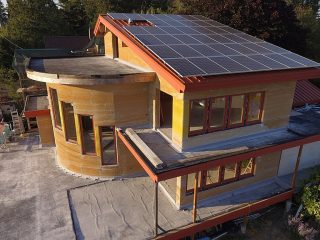The RIAI offers membership to technologists too, under the qualifier RIAI ArchTech and these members are bound to the RIAI’s code of professional conduct. Most RIAI architectural technologists work within an architectural practice supporting their fellow professionals by producing detailed designs, working drawings and carrying out other technology-related tasks. That said, some do provide independent technological services to clients directly. An RIAI ArchTech will probably have to study for one more year to gain a UK architectural technologist’s degree.
With regards to training, a chartered architectural technologist will typically gain an honours degree in architectural technology which covers areas such as detailed design and solutions, sustainability, technical and performance requirements as well as procurement, contracts and contract administration. A full-time honours degree is either three or four years in duration, depending on whether there is a work placement in the third year. To qualify for RIAI membership, the student must then complete two years of supervised and certified practical experience. In the case of CIAT, the candidate is then required to complete a supervised Chartered Architectural Technologist Professional and Occupational Performance (POP) Record which is assessed by a CIAT panel; the time this takes to complete is dependent on gaining the required experience (typically two to three years, or more). On successful completion of the POP Record the candidate is then invited to attend a Professional Practice Interview which they must successfully undertake before they are awarded chartered status, MCIAT. Technician members are required to complete a supervised Architectural Technician POP Record before having it successfully assessed by a CIAT POP Panel.
Fees
Before your designer starts any work it is essential that you agree and understand the level of services and fees relating to that level. The RIAI is very insistent that members make this clear in writing from the outset, including when stage payments are expected and whether the fee is based on a percentage of the total construction cost (most common), is an agreed lump sum fee or is based on an hourly rate. The RIAI also insists that the designer makes clear at the very beginning all the possible costs of construction; an RIAI consumer guide on costs published in 2008 gives approximate square metre costs for a range of different building types. These are only a guideline, using average building prices that are not regionally based, without allowance for inflation – or deflation! – and market conditions, so the final amount could vary considerably.
The fees payable will depend on the level of skills and experience held by the professional in his/her practice and there exists a misconception that architectural technologists are paid less than architects, but chartered architectural technologists are in fact just as qualified as architects to offer and provide the same level of service and as such, their fees do not differ. Indeed, many chartered architectural technologists and architects work together as partners or co-directors in a practice. An architectural technologist could even cost more than an architect if their specialist skills are required.
Before commencing work on any commission, CIAT’s code of conduct states that its chartered members must endeavour to ensure that their terms of engagement have been given in writing to the client. They must also satisfy themselves that those terms have been accepted and endeavour to ensure that the services offered or provided by their practice are appropriate to their client’s requirements.
Most architect fees start around 6% of the project value, but this will rise depending upon their level of involvement. When the architect’s fee is a percentage of the construction cost, they will receive it in 25% tranches. For example, if the architect is charging 10% of the total construction cost for a ‘full architectural service’, that is Initial Design, Developed Design, Detail Design, and Construction, and the total construction cost is €200,000, then the payments will be four equal amounts of €5,000 as each stage is completed.
In both ROI and NI competition law prohibits professional bodies from giving guidance on fee scales; it must be negotiated between the professional and the client. CIAT however does produce information sheets for its chartered members on the method of calculating their hourly rates/fees. The RIAI for its part publishes independent fee surveys which you may find useful as a basis for negotiation. Their latest survey, dating back to 2008, shows that for self-builds project fees recorded were as low as 3% to 4% and as high as 17%; the average stood at about 8.5%. The fees charged on extensions and renovations were higher, averaging 10% to 11%.






